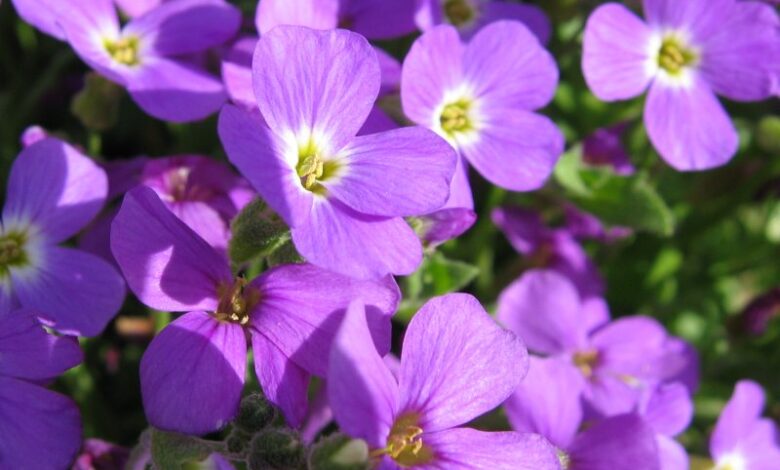Aubrietia (Aubretia deltoidea)

Aubrietia (Aubretia deltoidea) é uma planta deslumbrante que adiciona um toque de cor e beleza a qualquer jardim. Seu florescimento abundante e cores vibrantes a tornam uma escolha popular entre jardineiros e paisagistas. Neste artigo, exploraremos tudo o que você precisa saber sobre a Aubrietia, desde como cuidar das plantas em seu jardim até como propagá-las corretamente. Continue lendo para descobrir como criar um ambiente ideal para o crescimento da Aubrietia, os possíveis problemas de pragas e doenças que podem afetá-la, e como incorporar essa bela planta em seu paisagismo. Ao longo das estações, a Aubrietia oferece uma variedade de benefícios, e abordaremos cada um deles para que você possa aproveitar ao máximo essa encantadora adição ao seu jardim.
Everything You Need to Know About Aubrietia
Aubrietia, also known as Aubrieta, is a low-growing, flowering perennial plant that belongs to the Brassicaceae family. This charming plant is native to the Mediterranean region, particularly in rocky, mountainous areas. It is popular for its vibrant and cascading flowers, making it a favorite choice for rock gardens, borders, and containers.
Appearance: Aubrietia is characterized by its small, evergreen leaves and an abundance of small, four-petaled flowers that bloom in shades of purple, pink, and white. The flowers create a stunning carpet-like effect when in full bloom, adding a delightful burst of color to any garden.
Hardiness: This resilient plant is well-suited for growing in various climates and is known for its ability to thrive in harsh conditions. It is a popular choice for gardeners looking to add a touch of beauty to challenging areas such as rocky slopes and walls.
Low Maintenance: Aubrietia is celebrated for its low maintenance requirements, making it an excellent option for both experienced and novice gardeners. Once established, it requires minimal care and can withstand periods of drought.
Notable Features of Aubrietia:
-
- Rich and colorful flowers
-
- Low-growing and spreading habit
-
- Adaptability to various growing conditions
-
- Attractive to pollinators, such as bees and butterflies
Uses: In addition to its role as a ground cover, Aubrietia is also used to prevent soil erosion due to its spreading nature. Its ability to thrive in rocky and poor soil conditions makes it a valuable addition to any garden seeking to enhance visual appeal while promoting soil stability.
Symbolism: Aubrietia is often associated with feelings of admiration, devotion, and good fortune. Its presence in a garden is believed to bring a sense of positivity and charm.
Overall, Aubrietia is a delightful and versatile plant that can elevate the aesthetic appeal of any garden while requiring minimal upkeep.
Caring for Aubrietia Plants in Your Garden
Aubrietia plants, also known as Aubrieta, are low-growing, evergreen perennials that produce a stunning display of colorful flowers in the spring. Caring for Aubrietia plants in your garden is relatively easy and rewarding, as they are drought-tolerant and can thrive in various conditions.
Planting Aubrietia
When planting Aubrietia in your garden, choose a well-draining location with full sun to partial shade. Ensure the soil is not too rich, as this can lead to excessive foliage growth at the expense of flowers. Plant the seedlings or young plants in early spring, spacing them about 6 to 12 inches apart to allow for spreading.
Watering and Feeding
Once established, Aubrietia plants require minimal watering, as they are drought-tolerant. Water them during prolonged dry spells, but avoid overwatering, which can lead to root rot. Fertilize the plants sparingly in the spring with a balanced, slow-release fertilizer to promote healthy growth and flowering.
Pruning and Maintenance
After the flowering period, trim back the spent flowers to encourage a second flush of blooms and maintain a tidy appearance. Every few years, consider dividing the plants to rejuvenate them and prevent overcrowding.
Protecting from Pests and Diseases
Aubrietia plants are generally resistant to pests and diseases. However, keeping the garden area clean and providing good air circulation can help prevent issues such as powdery mildew. Inspect the plants regularly for any signs of pest infestation or disease and take appropriate action if necessary.
Seasonal Care
During the winter, protect Aubrietia plants from excessive moisture, as they are susceptible to rot in wet conditions. Mulch around the plants to insulate the roots and prevent frost heaving.
By following these simple care guidelines, you can enjoy the beauty of Aubrietia plants in your garden year after year.
The Ideal Conditions for Growing Aubrietia
When it comes to growing healthy and vibrant Aubrietia plants, providing the ideal conditions is crucial. Aubrietia, also known as rock cress, thrives in specific environmental settings that mimic its natural habitat.
Well-Drained Soil
One of the key factors for successful Aubrietia growth is well-drained soil. These plants prefer soil that is not waterlogged, as excessive moisture can lead to root rot and other issues. Adding organic matter to the soil can improve its drainage and provide essential nutrients for the plants.
Full Sun Exposure
Aubrietia plants flourish in full sun, so it’s important to place them in an area where they can receive at least 6-8 hours of direct sunlight per day. Adequate sun exposure promotes strong growth and an abundance of colorful flowers.
Moderate Watering
While Aubrietia requires well-drained soil, it’s essential to provide moderate watering, especially during dry periods. Regular watering helps the plants establish deep roots and maintain their vibrant appearance. However, overwatering should be avoided to prevent waterlogged soil.
Cooler Temperatures
Aubrietia plants thrive in cooler temperatures, making them well-suited for spring and early summer growth. They can tolerate some frost, but prolonged exposure to extreme heat may affect their overall health. Therefore, providing a slightly cooler environment can contribute to the optimal growth of Aubrietia.
Minimal Fertilization
When it comes to fertilization, Aubrietia plants generally require minimal feeding. Excessive fertilization can lead to excessive foliage growth at the expense of flowers. A balanced, slow-release fertilizer applied in early spring can provide the necessary nutrients for healthy growth without overstimulating the plants.
By creating these ideal conditions for growing Aubrietia, you can enjoy the beauty of these low-growing, spreading plants in your garden or landscape. Understanding and implementing these key factors will contribute to the overall success of cultivating vibrant and thriving Aubrietia plants.
Propagating Aubrietia the Right Way
Propagating Aubrietia is a great way to expand your garden and share the beauty of this lovely plant with others. By following the right techniques, you can ensure successful propagation and the healthy growth of new Aubrietia plants.
Methods of Propagation
There are several methods for propagating Aubrietia, including division, cuttings, and seed propagation. Each method has its own advantages and is suitable for different situations.
-
- Division: This method involves dividing an established Aubrietia plant into smaller sections, each with its own roots. It’s best done in the spring or early fall when the plant is not in active growth.
-
- Cuttings: Taking cuttings from healthy Aubrietia plants is another effective way to propagate. These cuttings can be rooted in a suitable growing medium to develop into new plants.
-
- Seed Propagation: Aubrietia can also be propagated from seeds. Collecting and sowing seeds at the right time can lead to successful germination and the growth of new plants.
Optimal Conditions for Propagation
Regardless of the method chosen, providing the right conditions is crucial for successful propagation. Adequate moisture, suitable temperature, and a well-draining growing medium are essential for the development of new Aubrietia plants.
It’s important to monitor the progress of propagated Aubrietia plants and provide the necessary care to ensure their establishment and growth. With proper attention and care, you can enjoy the rewards of successfully propagating Aubrietia and enhancing your garden with these beautiful plants.
Common Pests and Diseases Affecting Aubrietia Plants
Aubrietia plants are generally resistant to pests and diseases, but they can still be affected by a few common issues. It’s important to be aware of these potential problems so that you can take appropriate action to protect your plants.
Pests
While aubrietia plants are relatively pest-resistant, they can occasionally be affected by aphids, snails, and slugs. These pests can cause damage to the foliage and flowers of the plant, affecting its overall health and appearance.
-
- Aphids: These small insects can be found on the undersides of the leaves, sucking sap from the plant and causing distortion and discoloration.
-
- Snails and Slugs: These creatures can feed on the foliage and flowers of aubrietia, leaving behind a trail of slime and causing visible damage.
Diseases
While aubrietia is generally resistant to diseases, it can sometimes be affected by fungal issues such as powdery mildew and root rot.
-
- Powdery Mildew: This fungal disease appears as a white powdery substance on the leaves, affecting the plant’s ability to photosynthesize and thrive.
-
- Root Rot: Excessive moisture and poor drainage can lead to root rot in aubrietia plants, causing the roots to decay and affecting the overall health of the plant.
It’s important to monitor your aubrietia plants regularly for any signs of pest infestation or disease. By maintaining good garden hygiene, providing proper air circulation, and avoiding overwatering, you can help prevent these issues and keep your aubrietia plants healthy and thriving.
Designing with Aubrietia in Your Landscape
When it comes to designing your landscape, Aubrietia can be a versatile and beautiful addition. Its low-growing, spreading habit makes it an excellent choice for ground cover, rock gardens, or cascading over walls. The vibrant colors of Aubrietia flowers can add a pop of color to your landscape, creating a stunning visual impact.
Whether you’re looking to create a charming cottage garden or a more contemporary landscape design, Aubrietia can be incorporated in various ways to enhance the overall aesthetic appeal of your outdoor space.
Choosing the Right Location
Before incorporating Aubrietia into your landscape design, it’s important to consider the ideal location for this plant. Aubrietia thrives in well-drained soil and prefers full sun, making it an excellent choice for sunny slopes, rockeries, or as a border plant.
By carefully selecting the placement of Aubrietia in your landscape, you can take advantage of its cascading growth habit to create visually striking displays.
Complementary Planting
Pairing Aubrietia with other plants that complement its colors and growth habits can elevate the visual impact of your landscape design. Consider combining Aubrietia with low-growing perennials, such as creeping thyme or sedum, to create a harmonious and cohesive planting scheme.
Additionally, incorporating Aubrietia alongside spring-blooming bulbs can extend the seasonal interest of your landscape, providing bursts of color as the bulbs emerge.
Creating Visual Interest
Utilize Aubrietia’s ability to form a dense mat of foliage and flowers to create visually appealing patterns within your landscape design. Whether used to soften the edges of hardscaped areas or to cascade over retaining walls, Aubrietia can add texture and dimension to your outdoor space.
Furthermore, the use of Aubrietia in conjunction with other ground covers and ornamental grasses can contribute to the creation of dynamic and visually engaging landscapes.
By thoughtfully incorporating Aubrietia into your landscape design, you can enhance the overall beauty and appeal of your outdoor environment while enjoying the low-maintenance nature of this charming plant.
Aubrietia Through the Seasons
Throughout the seasons, Aubrietia offers a delightful display of color and beauty in your garden. This low-growing perennial plant is a sight to behold as it transitions through the different seasons of the year.
Spring
Spring is the time when Aubrietia truly shines. With the arrival of warmer weather, this plant bursts into a profusion of vibrant blooms, carpeting the ground with shades of purple, pink, and white. The sight of Aubrietia in full bloom is a sure sign that spring has arrived.
Summer
As summer sets in, Aubrietia continues to add charm to your garden with its evergreen foliage. While the blooming period may taper off, the lush greenery of Aubrietia provides a lovely backdrop for other summer flowers in your garden.
Fall
During fall, Aubrietia maintains its green foliage, offering a refreshing contrast to the changing colors of the surrounding plants and trees. Its resilience and ability to thrive even as the weather cools make it a valuable addition to any garden.
Winter
Winter may bring snow and frost, but Aubrietia’s evergreen leaves remain, providing a touch of color and life to an otherwise dormant landscape. Its hardy nature makes it a resilient presence, promising a beautiful resurgence when spring returns.
In conclusion, Aubrietia’s journey through the seasons is a testament to its enduring beauty and adaptability. Whether in full bloom or providing evergreen foliage, this plant adds a touch of elegance to your garden year-round.
Benefits of Adding Aubrietia to Your Garden
Aubrietia, also known as Aubrieta, is a stunning and versatile plant that can bring a range of benefits to your garden. Whether you are a seasoned gardener or a novice, adding Aubrietia to your garden can enhance its beauty and functionality in several ways.
1. Colorful Ground Cover
One of the key benefits of adding Aubrietia to your garden is its ability to serve as a vibrant ground cover. With its cascading foliage and colorful flowers, Aubrietia creates a stunning carpet of blooms that can transform bare patches of soil into a visual delight. The plant comes in a variety of shades, including purple, pink, and white, adding a pop of color to your garden landscape.
2. Low Maintenance
Aubrietia is a low-maintenance plant, making it an excellent choice for busy gardeners or those looking for fuss-free gardening. Once established, it requires minimal care and can thrive in various soil types, including rocky or sandy soils. Its ability to withstand dry conditions also makes it a resilient addition to your garden.
3. Attracts Pollinators
The nectar-rich flowers of Aubrietia attract pollinators such as bees and butterflies, contributing to the overall health of your garden ecosystem. By adding Aubrietia to your garden, you can create a welcoming environment for these beneficial insects, supporting biodiversity and the pollination of other plants in your garden.
4. Versatile Use
Whether you want to adorn rock gardens, slopes, or borders, Aubrietia offers versatility in its use. Its ability to thrive in challenging growing conditions makes it an ideal choice for various landscaping projects. Additionally, it can be used in containers or hanging baskets, adding a touch of elegance to your outdoor spaces.
Overall, the benefits of adding Aubrietia to your garden make it a valuable addition that can enhance the visual appeal, ecological balance, and low-maintenance aspects of your outdoor space.




